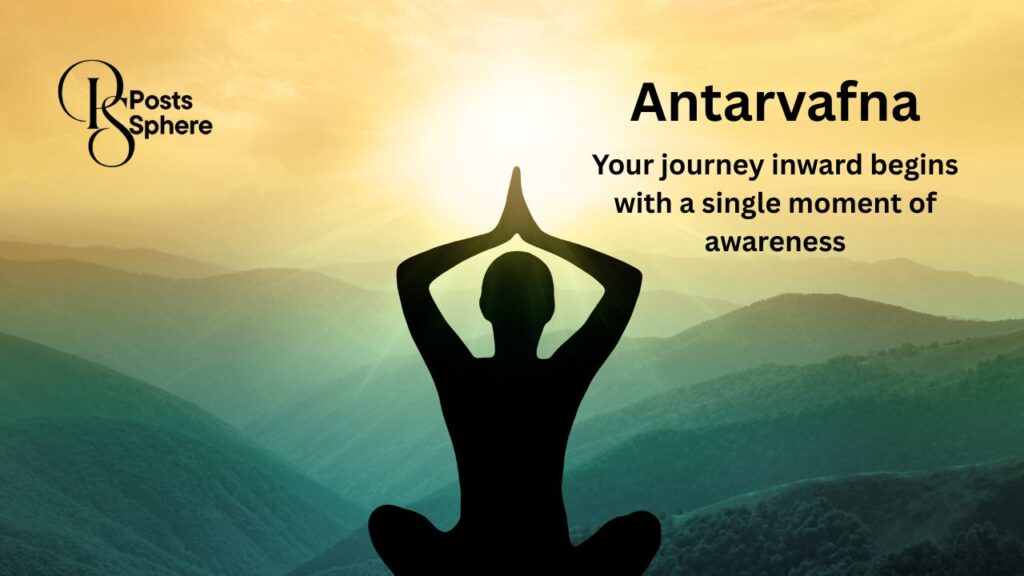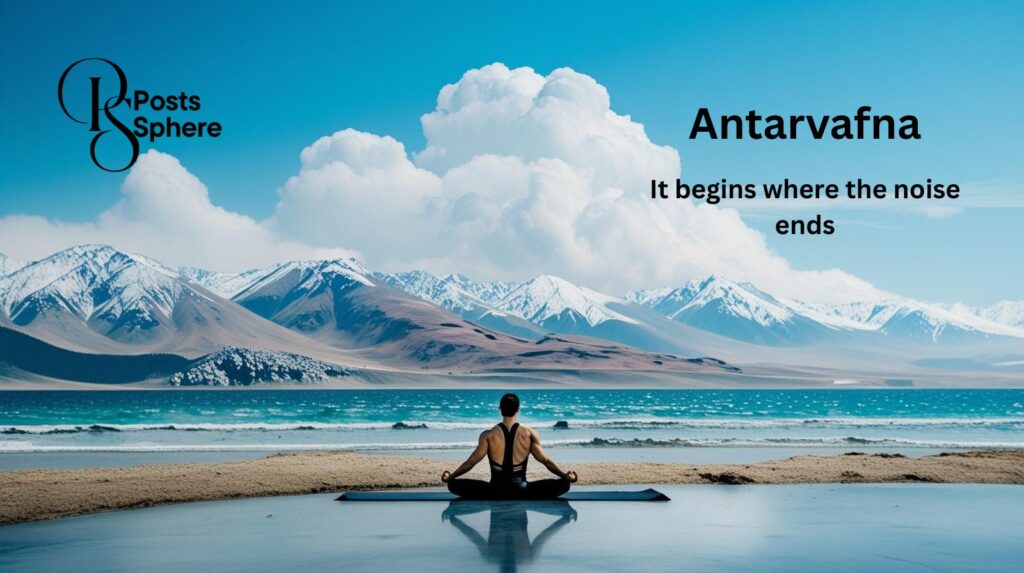In today’s fast-paced world, stress, overwhelm, and distraction have become normal. But deep within us lies a quiet space of calm—if only we’d stop long enough to notice. That’s exactly what antarvafna helps us do.
This ancient practice from India isn’t just a meditation trend. It’s a transformative tool to reconnect with your thoughts and feelings, gain emotional clarity, and live more intentionally in your daily life.
In this guide, we’re delving into the essence of antarvafna—what it means, how it works, and why it matters today.
Understanding Antarvafna: Rooted in Ancient Wisdom and Still Relevant Today
The word antarvafna is Sanskrit in origin. It’s formed from two root words:
- Antar, meaning “inner”
- Vafna, meaning “to observe” or “to contemplate”
Together, antarvafna invites you to practice inner observation—to turn inward, not to fix anything, but to witness what’s there with openness and honesty.
This concept is rooted in ancient Indian spiritual traditions—including Hinduism, Buddhism, and Jainism—where self-inquiry was seen as the key to freedom and peace.
Antar View: Shifting the Way You See Yourself
Practicing antarvafna changes your antar view—your inner lens. When you stop reacting and start reflecting, your inner world opens up.
You become aware of:
- Emotional patterns
- Recurring thoughts
- Hidden fears
- Forgotten dreams
This subtle shift helps you make decisions that reflect your true self instead of society’s expectations.
Antarvasna Synonyms and the Language of Inner Desires
The word antarvasna, often used alongside antarvafna, refers to “inner desires.” While antarvafna focuses on observation, antarvasna touches on what we want or crave deeply inside.
Synonyms in Sanskrit and Hindi include:
- Vasana (impression or tendency)
- Iccha (desire)
- Spandana (inner vibration or impulse)
Understanding these terms can deepen your spiritual practice, as you begin to recognize how desires shape your mental world.
Antavin Syrup Uses: A Tangential Connection to Mental Wellness
You may be surprised to see antavin syrup pop up in relation to antarvafna. While not directly connected, antavin syrup uses are often associated with treating anxiety or insomnia—conditions that arise when we’re out of alignment internally.
Antarvafna offers a natural approach to calming the mind. When practiced regularly, it can:
- Reduce mental noise
- Improve sleep quality
- Balance emotional states—without medication
Still, always consult a medical professional before altering your health routine.
Antarvis and Antarview: Tools for Observation and Reflection
Antarvis could be seen as a poetic or modern tool—a metaphorical lens for inward-looking vision. Meanwhile, antarview implies a conscious practice of “viewing from the inside.”
Both terms echo the same truth:
True clarity doesn’t come from changing the world—it comes from understanding yourself.
And antarvafna encourages just that kind of honest internal look.
Antachaba and Antarya1132L: The Spiritual and Symbolic Side of Inward Inquiry
While Antachaba and Antarya1132L may not be mainstream terms, in the context of spiritual traditions or symbolic language, they can represent:

- The inner flame of awareness
- The sacred observer within
- The coded or encrypted layers of the self
Whether metaphorical or esoteric, they serve as reminders that antarvafna is about peeling back the layers of identity.
Benefits of Practicing Antarvafna in Daily Life
Practicing antarvafna in everyday life doesn’t require robes or rituals. All it takes is presence and sincerity. Here’s what you gain with consistent practice:
- Emotional clarity: You see what’s really bothering you.
- Improved relationships: You respond with empathy, not ego.
- Mental stillness: You’re less reactive, more intentional.
- Spiritual grounding: You feel rooted even when life feels chaotic.
These are long-term benefits—ones that compound with time, like inner savings in the bank of peace.
Principles of Antarvafna: The Core of the Ancient Practice
Let’s break down the timeless principles of antarvafna:
- Stillness: Create space for silence and solitude.
- Witnessing: Observe without interference.
- Non-judgment: Allow feelings and thoughts without labeling them as good or bad.
- Consistency: Make it part of your daily life, even if only for five minutes.
- Compassion: Be gentle with yourself during the process.
These principles are found throughout ancient texts, especially in Vedic and yogic philosophy.
Embracing Antarvafna in a Fast-Paced World
It may sound impossible to practice self-reflection in the modern world, but embracing antarvafna is more necessary than ever. In fact, the busier your life, the more vital it is to pause.
Try starting with:
- 5-minute morning sit: Before you touch your phone
- Midday check-in: One deep breath, one honest question: “How am I really feeling?”
- Evening journaling: Write down what surprised you emotionally that day
You’ll soon notice how antarvafna offers a counterbalance to daily stress.
Antarvafna Encourages Conscious Living Through Simple Steps
Here’s a practical way to build antarvafna into your routine:

- Sit in silence—No phone, no agenda.
- Let go of control—No need to “meditate.” Just observe.
- Watch thoughts and feelings—Like clouds passing in the sky.
- Write down reflections—Capture what stood out or repeated.
- Repeat daily—Make it a habit, not a chore.
It’s not about doing it “right”—it’s about showing up for yourself.
Final Reflection: Why Antarvafna Is More Relevant Than Ever
In an era of algorithms, instant gratification, and hyper-productivity, antarvafna is a radical act of remembering yourself.
It teaches you:
- To listen before you speak
- To feel before you react
- To know yourself before you define yourself
As we continue to evolve socially and technologically, antarvafna invites us back to the one place we often avoid: our inner world.
But it is there—in that quiet inner cave—that peace, purpose, and power are waiting.
Frequently Asked Questions (FAQs) About Antarvafna
1. What is antarvafna in simple words?
Antarvafna is the ancient Indian practice of inner observation. It means quietly reflecting on your thoughts and feelings without trying to change them. It’s about listening to your inner world to gain emotional clarity and peace.
2. How is antarvafna different from meditation or mindfulness?
While meditation often involves breath control or focus techniques, and mindfulness emphasizes staying present, antarvafna invites you to simply observe your inner landscape. There’s no control—only awareness.
3. Why is embracing antarvafna important in today’s fast-paced world?
In a fast-paced world, people often suppress their emotions and desires. Embracing antarvafna helps you slow down, connect with your true self, and make choices that align with your values.
4. Is antarvafna related to any spiritual traditions?
Yes. The principles of antarvafna are rooted in ancient Indian spiritual traditions, particularly in the Vedas, Upanishads, and Buddhist texts, where self-inquiry and awareness were central to personal growth.
5. What are the main benefits of practicing antarvafna daily?
The benefits of practicing antarvafna in daily life include:
- Reduced anxiety and stress
- Sharper self-awareness
- Improved decision-making
- Stronger relationships
- A deeper sense of peace
6. Can antarvafna be practiced without any spiritual beliefs?
Absolutely. While antarvafna is inspired by ancient wisdom, it’s not tied to any religion. Anyone can use it as a self-awareness tool in their everyday life—whether they’re spiritual, secular, or somewhere in between.
7. How long should I practice antarvafna each day?
Start with just 5 minutes a day. As you grow more comfortable, extend it to 10–15 minutes. The key is consistency over duration.
8. What if I get uncomfortable thoughts during antarvafna?
That’s completely normal. Antarvafna encourages you to observe those thoughts without judging them. Discomfort is often where transformation begins.
9. Are there tools or apps to support my antarvafna journey?
While antarvafna doesn’t require tools, you can use:
- Journaling apps or notebooks to track reflections
- Timers or ambient sound apps
- Even voice notes for raw emotional captures
That said, the practice itself is minimal—no tech required.
10. How does antarvafna relate to emotional health and modern wellness?
Just like antavin syrup uses might support physical calm, antarvafna offers a natural mental detox. It builds long-term emotional clarity by helping you process your inner world instead of escaping it.
